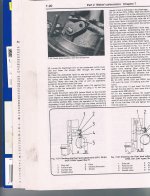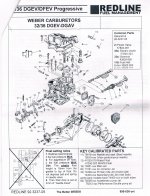PoliceMonkey161
New member
Believe it or not, the fact that it wants to fire up after pumping the pedal is a good thing. When you pump the gas pedal, it is forcing fuel into the ventrui’s , so we have a clog or restriction somewhere on the low speed (idle) circuit. I’m a little curious when you say “I have adjusted/set the idle mixture screws (one on each side)”? Maybe you where turning the idling jet holders(#35 in link 1)? There is one on each side, but the idle adjustments are only on one side? Regardless, the link below is the schematic for the carb. We would be turning number 58 (idle mixture) and 62 (idle speed). It’s a confusing drawing, but hey I have a manual that is not even in English. FYI, some of those parts you will not have.
At this point, I would recommend rebuilding the carb. You could try to disassemble and clean it, but some gasket or ring somewhere will tear (always does!) and you’ll just be waiting on parts. The kit is available in a couple of places (your local auto parts store is not likely to have it). I deal with (link#2) Carbs Unlimited, you may find the kit for less but these folks have support if you need it. Regardless, get the kit with the power valve (cu-32K).
Rebuilding the carb is not overly complicated (even though the schematic has like a billon parts on it), take your time during disassembly and take plenty of photo’s (especially of your linkage as you take it apart). The hardest thing you’re going to do is re-set the float and we’ll do it together. If you’re so inclined, this is a great time to clean the outside of the carb as well. Brake cleaner works great, especially with an old tooth brush.
1. Weber 32/36 DGEV DGAV Diagram
2. Rebuild Kits Weber DGEV Carburetors - Carbs Unlimited
At this point, I would recommend rebuilding the carb. You could try to disassemble and clean it, but some gasket or ring somewhere will tear (always does!) and you’ll just be waiting on parts. The kit is available in a couple of places (your local auto parts store is not likely to have it). I deal with (link#2) Carbs Unlimited, you may find the kit for less but these folks have support if you need it. Regardless, get the kit with the power valve (cu-32K).
Rebuilding the carb is not overly complicated (even though the schematic has like a billon parts on it), take your time during disassembly and take plenty of photo’s (especially of your linkage as you take it apart). The hardest thing you’re going to do is re-set the float and we’ll do it together. If you’re so inclined, this is a great time to clean the outside of the carb as well. Brake cleaner works great, especially with an old tooth brush.
1. Weber 32/36 DGEV DGAV Diagram
2. Rebuild Kits Weber DGEV Carburetors - Carbs Unlimited



